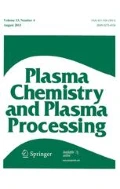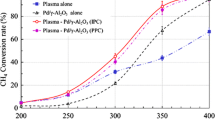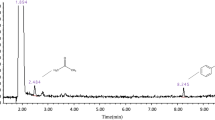Abstract
This work has dealt with the efficient degradation of styrene in a reactor system comprised of non-thermal plasma and Pd/ZSM-5 catalyst at room temperature. The problems regarding the individual plasma and catalytic processes such as poor low-temperature activity of the catalytic process and incomplete oxidation of the plasma process were complemented by the combination of both. The results demonstrated that the plasma-coupled Pd/ZSM-5 catalyst significantly enhanced both the styrene oxidation and the CO2 selectivity as compared with the plasma-alone case, greatly reducing the byproducts. The styrene degradation efficiency proportionally increased with increasing the specific input energy. Ozone formed by the plasma played an important role in the oxidation of styrene. The Pd/ZSM5 catalyst could be activated by the plasma, which greatly enhanced the performance for the styrene removal.












Similar content being viewed by others

References
Wang Z, Yang H, Liu R et al (2020) Probing toluene catalytic removal mechanism over supported Pt nano- and single-atom-catalyst. J Hazard Mater 392:122258
Veerapandian S, Leys C, De Geyter N, Morent R (2017) Abatement of VOCs using packed bed non-thermal plasma reactors: a review. Catalysts 7:113
Lu W, Abbas Y, Mustafa MF et al (2019) A review on application of dielectric barrier discharge plasma technology on the abatement of volatile organic compounds. Front Environ Sci Eng 13:30
Gibbs BF, Mulligan CN (1997) Styrene toxicity: an ecotoxicological assessment. Ecotoxicol Environ Safe 38:181–194
Zhang H, Li K, Sun T et al (2014) Removal of styrene using dielectric barrier discharge plasmas combined with sol–gel prepared TiO2 coated γ-Al2O3. Chem Eng J 241:92–102
Zhang H, Li K, Li L et al (2018) High efficient styrene mineralization through novel NiO–TiO2–Al2O3 packed pre-treatment/treatment/post-treatment dielectric barrier discharge plasma. Chem Eng J 343:759–769
Zhong J, Zeng Y, Chen D et al (2020) Toluene oxidation over Co3+-rich spinel Co3O4: evaluation of chemical and by-product species identified by in situ DRIFTS combined with PTR–TOF–MS. J Hazard Mater 386:121957
Ostrovsky YV, Zabortsev GM, Shpak AA et al (2017) Catalytic oxidation of volatile organic compounds in industrial off-gases. Eurasian Chem J 4:31
Boulinguiez B, Le Cloirec P (2010) Adsorption on activated carbons of five selected volatile organic compounds present in biogas: comparison of granular and fiber cloth materials. Energy Fuels 24:4756–4765
Wang X, Jia X, Wen J (2010) Transient modeling of toluene waste gas biotreatment in a gas–liquid airlift loop reactor. Chem Eng J 159:1–10
Xiao G, Xu W, Wu R et al (2014) Non-thermal plasmas for VOCs abatement. Plasma Chem Plasma Proc 34:1033–1065
Schiavon M, Torretta V, Casazza A, Ragazzi M (2017) Non-thermal plasma as an innovative option for the abatement of volatile organic compounds: a review. Water Air Soil Pollut 228:388
Tang Q, Jiang W, Cheng Y et al (2011) Generation of reactive species by gas-phase dielectric barrier discharges. Ind Eng Chem Res 50:9839–9846
Pekárek S, Khun J (2006) Non-thermal plasma at atmospheric pressure for ozone generation and volatile organic compounds decomposition. Acta Phys Slovaca 56:109–113
Magureanu M, Mandache NB, Parvulescu VI et al (2007) Improved performance of non-thermal plasma reactor during decomposition of trichloroethylene: optimization of the reactor geometry and introduction of catalytic electrode. Appl Catal B Environ 74:270–277
Mista W, Kacprzyk R (2008) Decomposition of toluene using non-thermal plasma reactor at room temperature. Catal Today 137:345–349
Zhang X, Feng F, Li S et al (2013) Aerosol formation from styrene removal with an AC/DC streamer corona plasma system in air. Chem Eng J 232:527–533
Vandenbroucke AM, Morent R, De Geyter N, Leys C (2011) Non-thermal plasmas for non-catalytic and catalytic VOC abatement. J Hazard Mater 195:30–54
Zhu R, Mao Y, Jiang L, Chen J (2015) Performance of chlorobenzene removal in a nonthermal plasma catalysis reactor and evaluation of its byproducts. Chem Eng J 279:463–471
Zhang J, Li Y, Zhang Y et al (2015) Effect of support on the activity of Ag-based catalysts for formaldehyde oxidation. Sci Rep 5:1–10
Veerapandian KPS, De Geyter N, Giraudon J-M et al (2019) The use of zeolites for VOCs abatement by combining non-thermal plasma, adsorption, and/or catalysis: a review. Catalysts 9:98
Freitas CMAS, Soares OSGP, Órfão JJM et al (2015) Highly efficient reduction of bromate to bromide over mono and bimetallic ZSM5 catalysts. Green Chem 17:4247–4254
Vercammen KLL, Berezin AA, Lox F, Chang J-S (2017) Non-thermal plasma techniques for the reduction of volatile organic compounds in air streams: a critical review. J Adv Oxid Technol 2:312–329
Liu CJ, Zou J, Yu K et al (2006) Plasma application for more environmentally friendly catalyst preparation. Pure Appl Chem 78:1227–1238
Gandhi MS, Ananth A, Mok YS et al (2014) Effect of porosity of α-alumina on non-thermal plasma decomposition of ethylene in a dielectric-packed bed reactor. Res Chem Intermed 40:1483–1493
Bo Z, Yan JH, Li XD et al (2007) Effects of oxygen and water vapor on volatile organic compounds decomposition using gliding arc gas discharge. Plasma Chem Plasma Process 27:546–558
Chen HL, Lee HM, Chen SH, Chang MB (2008) Review of packed-bed plasma reactor for ozone generation and air pollution control. Ind Eng Chem Res 47:2122–2130
Sekiguchi K, Sanada A, Sakamoto K (2003) Degradation of toluene with an ozone-decomposition catalyst in the presence of ozone, and the combined effect of TiO2 addition. Catal Commun 4:247–252
Konova P, Stoyanova M, Naydenov A et al (2006) Catalytic oxidation of VOCs and CO by ozone over alumina supported cobalt oxide. Appl Catal A Gen 298:109–114
Zhu T, Li J, Jin Y et al (2008) Decomposition of benzene by non-thermal plasma processing: photocatalyst and ozone effect. Int J Environ Sci Technol 5:375–384
Demidiouk V, Chae JO (2005) Decomposition of volatile organic compounds in plasma–catalytic system. IEEE Trans Plasma Sci 33:157–161
Jiang N, Lu N, Shang K et al (2013) Innovative approach for benzene degradation using hybrid surface/packed-bed discharge plasmas. Environ Sci Technol 47:9898–9903
Kohno H, Berezin AA, Chang JS (1998) Destruction of volatile organic compounds used in a semiconductor industry by a capillary tube discharge reactor. IEEE Trans Ind Appl 34:953–966
Mas Haris MR, Kathiresan S, Mohan S (2010) FT-IR and FT-Raman spectra and normal coordinate analysis of poly methyl methacrylate. Der Pharma Chem 2:316–323
Islam MT, Rodríguez-Hornedo N, Ciotti S, Ackermann C (2004) Fourier transform infrared spectroscopy for the analysis of neutralizer–carbomer and surfactant–carbomer interactions in aqueous, hydroalcoholic and anhydrous gel formulations. AAPS J 6:4–10
Mo J, Zhang Y, Xu Q et al (2009) Photocatalytic purification of volatile organic compounds in indoor air: a literature review. Atmos Environ 43:2229–2246
Ogata A, Ito D, Mizuno K et al (2002) Effect of coexisting components on aromatic decomposition in a packed-bed plasma reactor. Appl Catal A Gen 236:9–15
Acknowledgements
This work was funded by Technology Development Program to Solve Climate Changes (NRF-2019M1A2A2103912) through NRF (National Research Foundation of Korea) and by the National Research Council of Science & Technology (NST) granted by the Korea government (MSIT) (Project No. CAP-18-08-KIMM). A part of this research was supported by the 2020 scientific promotion program funded by Jeju National University.
Author information
Authors and Affiliations
Corresponding author
Additional information
Publisher's Note
Springer Nature remains neutral with regard to jurisdictional claims in published maps and institutional affiliations.
Rights and permissions
About this article
Cite this article
Nguyen, V.T., Nguyen, D.B., Heo, I. et al. Efficient Degradation of Styrene in a Nonthermal Plasma–Catalytic System Over Pd/ZSM-5 Catalyst. Plasma Chem Plasma Process 40, 1207–1220 (2020). https://doi.org/10.1007/s11090-020-10088-w
Received:
Accepted:
Published:
Issue Date:
DOI: https://doi.org/10.1007/s11090-020-10088-w



